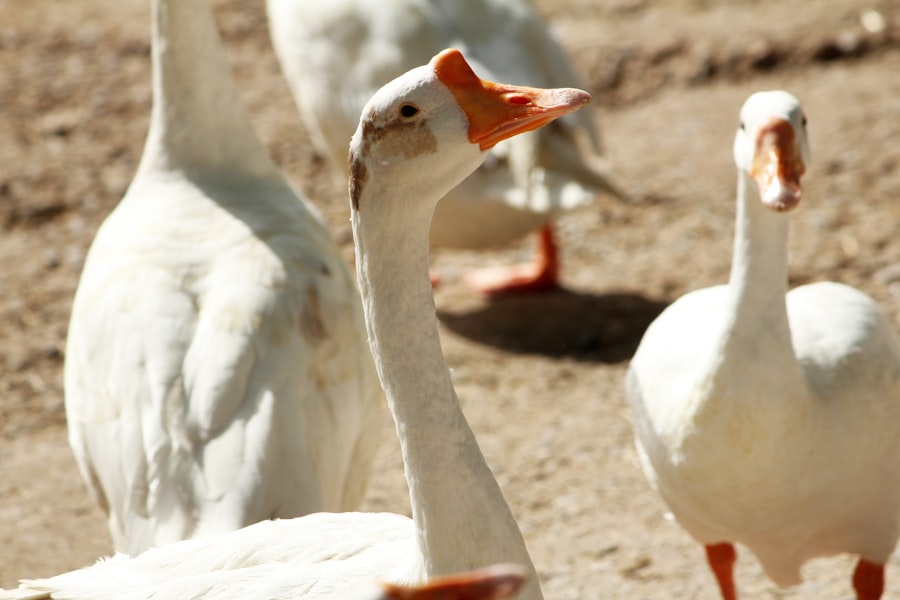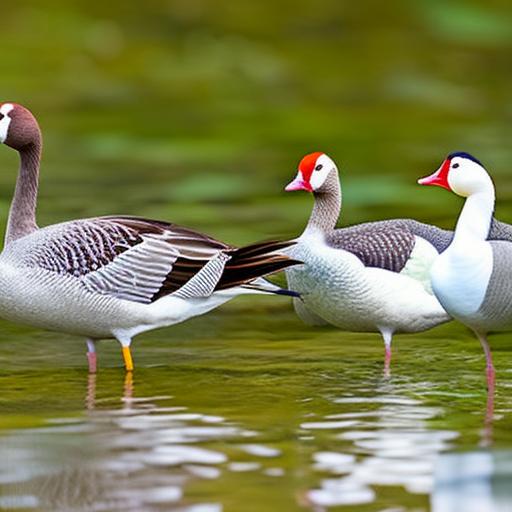Geese are an important part of the local agriculture industry in the Philippines. They are primarily raised for their meat, eggs, and feathers. There are several different breeds of geese that are commonly found in the country, each with its own unique characteristics and advantages.
Geese farming has been a traditional practice in the Philippines for many years. The meat and eggs produced by geese are highly valued for their taste and nutritional value. Additionally, geese feathers are used in various industries, including fashion and home decor.
Key Takeaways
- Geese breeds in the Philippines include the Philippine Native, Chinese, Embden, Toulouse, African, American Buff, Sebastopol, and Pilgrim.
- The Philippine Native goose is a unique breed that is smaller in size and has a distinct appearance.
- The Chinese goose is a popular choice for commercial farms due to its high egg production and adaptability to different environments.
- The Embden goose is a large and hardy breed that is commonly raised for meat production.
- The Toulouse goose is a heavyweight breed that is ideal for meat production, but also lays a decent amount of eggs.
- Geese breeding and management in the Philippines require proper housing, feeding, and health care, as well as regular monitoring of egg production and growth rates.
- Best practices for geese breeding in the Philippines include selecting healthy breeding stock, providing adequate nutrition and space, and implementing biosecurity measures to prevent disease outbreaks.
- The Sebastopol goose is a fancy breed known for its curly feathers, but requires extra care and attention due to its unique appearance.
- The Pilgrim goose is a docile breed that is suitable for small farms and backyard flocks, and is known for its calm temperament and good egg-laying abilities.
The Philippine Native Goose: A Unique Breed
The Philippine Native Goose is a breed that is indigenous to the country. It is known for its small size and distinctive appearance. The Philippine Native Goose has a black plumage with white markings on its head and neck. It also has a short and stout body, which makes it well-suited for grazing in small spaces.
One of the unique characteristics of the Philippine Native Goose is its ability to adapt to different environments. It can thrive in both rural and urban settings, making it a versatile breed for farmers. However, one disadvantage of raising this breed is its low egg production compared to other breeds.
The Chinese Goose: A Popular Choice for Commercial Farms
The Chinese Goose is one of the most popular breeds of geese in the Philippines, especially among commercial farms. It is known for its large size and high egg production. The Chinese Goose has a white plumage with orange bills and feet.
One of the reasons why the Chinese Goose is a popular choice for commercial farms is its ability to lay a large number of eggs. It can lay up to 60-70 eggs per year, making it highly profitable for farmers. Additionally, the Chinese Goose has a fast growth rate, which means that it can be ready for market at an early age.
When raising Chinese Geese, it is important to provide them with a spacious and secure enclosure. They are known to be good foragers, so it is important to provide them with ample space to graze. Additionally, they should be provided with a balanced diet that includes a mix of grains, greens, and protein.
The Embden Goose: A Large and Hardy Breed
The Embden Goose is a breed that originated in Germany but has become popular in the Philippines due to its hardiness and large size. It has a white plumage and orange bills and feet. The Embden Goose is known for its ability to withstand harsh weather conditions and adapt to different environments.
One of the advantages of raising the Embden Goose is its large size. It can grow up to 30 pounds, making it an ideal breed for meat production. Additionally, the Embden Goose has a calm and docile temperament, which makes it easy to handle and manage.
The Embden Goose is also known for its high egg production. It can lay up to 40-50 eggs per year, making it a good choice for farmers who are looking to produce both meat and eggs. However, one challenge of raising this breed is its high feed consumption, so it is important to provide them with a balanced diet.
The Toulouse Goose: A Heavyweight Breed for Meat Production
The Toulouse Goose is a breed that originated in France but has become popular in the Philippines due to its large size and high meat production. It has a gray plumage with orange bills and feet. The Toulouse Goose is known for its ability to grow quickly and reach a large size.
One of the advantages of raising the Toulouse Goose is its high meat yield. It can grow up to 35 pounds, making it an ideal breed for meat production. Additionally, the Toulouse Goose has a calm temperament, which makes it easy to handle and manage.
However, one challenge of raising the Toulouse Goose is its low egg production compared to other breeds. It can lay up to 20-30 eggs per year, which is lower than breeds like the Chinese Goose or the Embden Goose. Additionally, the Toulouse Goose requires a spacious and secure enclosure, as it is prone to obesity and health issues if not properly managed.
The African Goose: A Dual-Purpose Breed for Meat and Eggs

The African Goose is a breed that originated in Africa but has become popular in the Philippines due to its ability to produce both meat and eggs. It has a gray plumage with orange bills and feet. The African Goose is known for its large size and high egg production.
One of the advantages of raising the African Goose is its ability to produce both meat and eggs. It can grow up to 25 pounds, making it suitable for meat production. Additionally, the African Goose can lay up to 40-50 eggs per year, making it a good choice for farmers who are looking to produce both meat and eggs.
When raising African Geese, it is important to provide them with a spacious and secure enclosure. They are known to be good foragers, so it is important to provide them with ample space to graze. Additionally, they should be provided with a balanced diet that includes a mix of grains, greens, and protein.
The American Buff Goose: A Rare Breed with a Distinctive Color
The American Buff Goose is a rare breed that originated in the United States but has become popular in the Philippines due to its distinctive color and unique characteristics. It has a buff-colored plumage with orange bills and feet. The American Buff Goose is known for its calm temperament and good mothering instincts.
One of the characteristics that make the American Buff Goose unique is its color. It has a buff-colored plumage that is highly valued in the fashion industry. Additionally, the American Buff Goose is known for its high egg production and good meat quality.
The American Buff Goose is a hardy breed that can adapt to different environments. It is also known for its calm temperament, which makes it easy to handle and manage. However, one challenge of raising this breed is its low growth rate compared to other breeds.
The Sebastopol Goose: A Fancy Breed Known for its Curly Feathers
The Sebastopol Goose is a fancy breed that originated in Europe but has become popular in the Philippines due to its unique appearance and distinctive curly feathers. It has a white plumage with orange bills and feet. The Sebastopol Goose is known for its calm temperament and good meat quality.
One of the characteristics that make the Sebastopol Goose unique is its curly feathers. The feathers of the Sebastopol Goose are long and curly, which gives it a fancy and elegant appearance. Additionally, the Sebastopol Goose is known for its high egg production and good meat quality.
When raising Sebastopol Geese, it is important to provide them with a spacious and secure enclosure. They are known to be good foragers, so it is important to provide them with ample space to graze. Additionally, they should be provided with a balanced diet that includes a mix of grains, greens, and protein.
The Pilgrim Goose: A Docile Breed Suitable for Small Farms
The Pilgrim Goose is a breed that originated in the United States but has become popular in the Philippines due to its docile temperament and suitability for small farms. It has a gray plumage with orange bills and feet. The Pilgrim Goose is known for its calm temperament and good egg production.
One of the advantages of raising the Pilgrim Goose is its docile temperament. It is known to be friendly and easy to handle, making it suitable for small farms or backyard setups. Additionally, the Pilgrim Goose can lay up to 30-40 eggs per year, making it a good choice for farmers who are looking to produce eggs.
However, one challenge of raising the Pilgrim Goose is its low meat yield compared to other breeds. It has a smaller size and lower meat quality compared to breeds like the Toulouse Goose or the Embden Goose. Additionally, the Pilgrim Goose requires a spacious and secure enclosure, as it is prone to obesity and health issues if not properly managed.
Geese Breeding and Management in the Philippines: Tips and Best Practices
Breeding and managing geese in the Philippines requires careful planning and attention to detail. Here are some general tips and best practices for successful geese farming:
1. Provide a spacious and secure enclosure: Geese require ample space to graze and roam around. It is important to provide them with a spacious enclosure that is secure from predators and other threats.
2. Provide a balanced diet: Geese should be provided with a balanced diet that includes a mix of grains, greens, and protein. It is important to ensure that they have access to fresh water at all times.
3. Monitor their health: Regularly check your geese for any signs of illness or disease. It is important to provide them with proper veterinary care and vaccinations to prevent any health issues.
4. Practice good hygiene: Keep their enclosure clean and free from waste buildup. Regularly clean their water containers and provide them with fresh bedding.
5. Monitor their behavior: Observe your geese for any signs of aggression or stress. It is important to provide them with a calm and stress-free environment.
6. Consider the climate: Geese are adaptable animals, but it is important to consider the climate in your area when raising them. Provide them with shade during hot weather and protection from cold temperatures.
7. Plan for breeding: If you are planning to breed your geese, it is important to have a separate breeding area and nesting boxes. Provide them with privacy and a comfortable environment for successful breeding.
8. Be prepared for challenges: Geese farming can come with its own set of challenges, such as predators, diseases, and weather conditions. It is important to be prepared and have a plan in place to overcome these challenges.
Geese farming is an important part of the local agriculture industry in the Philippines. There are several different breeds of geese that are commonly found in the country, each with its own unique characteristics and advantages. Proper breeding and management are essential for successful geese farming.
The Philippine Native Goose, Chinese Goose, Embden Goose, Toulouse Goose, African Goose, American Buff Goose, Sebastopol Goose, and Pilgrim Goose are some of the popular breeds of geese in the Philippines. Each breed has its own unique characteristics and advantages for meat production, egg production, or both.
By following best practices for feeding, housing, and caring for geese, farmers can ensure the health and productivity of their flock. While there may be challenges along the way, raising geese can be a viable option in the local agriculture industry and provide farmers with a profitable venture.
If you’re interested in learning more about the different breeds of geese in the Philippines, you might also find this article on poultrywizard.com helpful. It provides valuable information on how to build a chicken coop with a nest box, which is essential for creating a comfortable and safe environment for your geese. Check it out here: https://poultrywizard.com/keeping-chickens/chicken-coop-nest-box/. Additionally, if you’re looking for tips on portaging your chicken coop, this article offers practical advice and step-by-step instructions: https://poultrywizard.com/keeping-chickens/chicken-coop-portage/. Lastly, if you’re located in Grand Island, NE, and want to explore local resources for chicken coops, this article highlights some options available in your area: https://poultrywizard.com/keeping-chickens/chicken-coop-grand-island-ne/. Happy reading!
FAQs
What are the different breeds of geese in the Philippines?
There are several breeds of geese in the Philippines, including the African, Chinese, Embden, Toulouse, and Pilgrim geese.
What is the African goose?
The African goose is a large breed of domestic goose that is known for its distinctive knob on its forehead. They are primarily raised for meat production.
What is the Chinese goose?
The Chinese goose is a smaller breed of domestic goose that is known for its loud honking and excellent egg-laying abilities. They are primarily raised for their eggs and meat.
What is the Embden goose?
The Embden goose is a large breed of domestic goose that is known for its white feathers and calm temperament. They are primarily raised for meat production.
What is the Toulouse goose?
The Toulouse goose is a large breed of domestic goose that is known for its gray feathers and excellent meat quality. They are primarily raised for meat production.
What is the Pilgrim goose?
The Pilgrim goose is a medium-sized breed of domestic goose that is known for its calm temperament and excellent egg-laying abilities. They are primarily raised for their eggs and meat.
Meet Walter, the feathered-friend fanatic of Florida! Nestled in the sunshine state, Walter struts through life with his feathered companions, clucking his way to happiness. With a coop that’s fancier than a five-star hotel, he’s the Don Juan of the chicken world. When he’s not teaching his hens to do the cha-cha, you’ll find him in a heated debate with his prized rooster, Sir Clucks-a-Lot. Walter’s poultry passion is no yolk; he’s the sunny-side-up guy you never knew you needed in your flock of friends!







